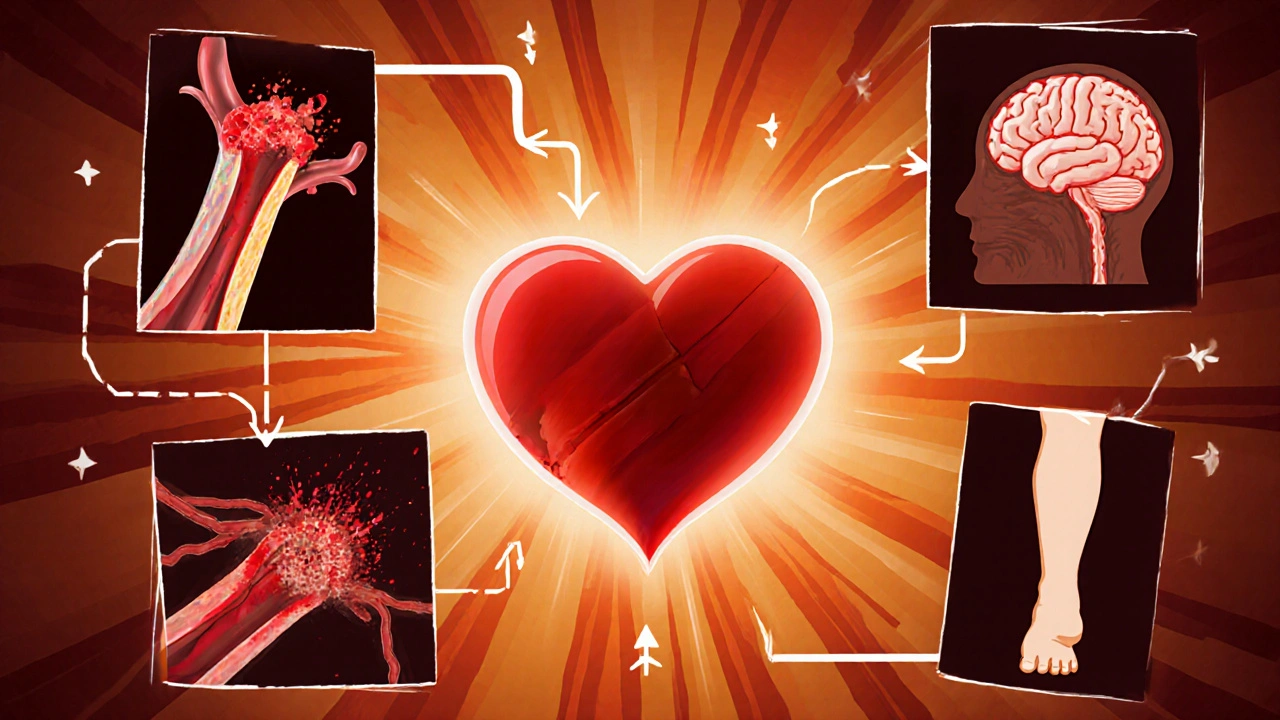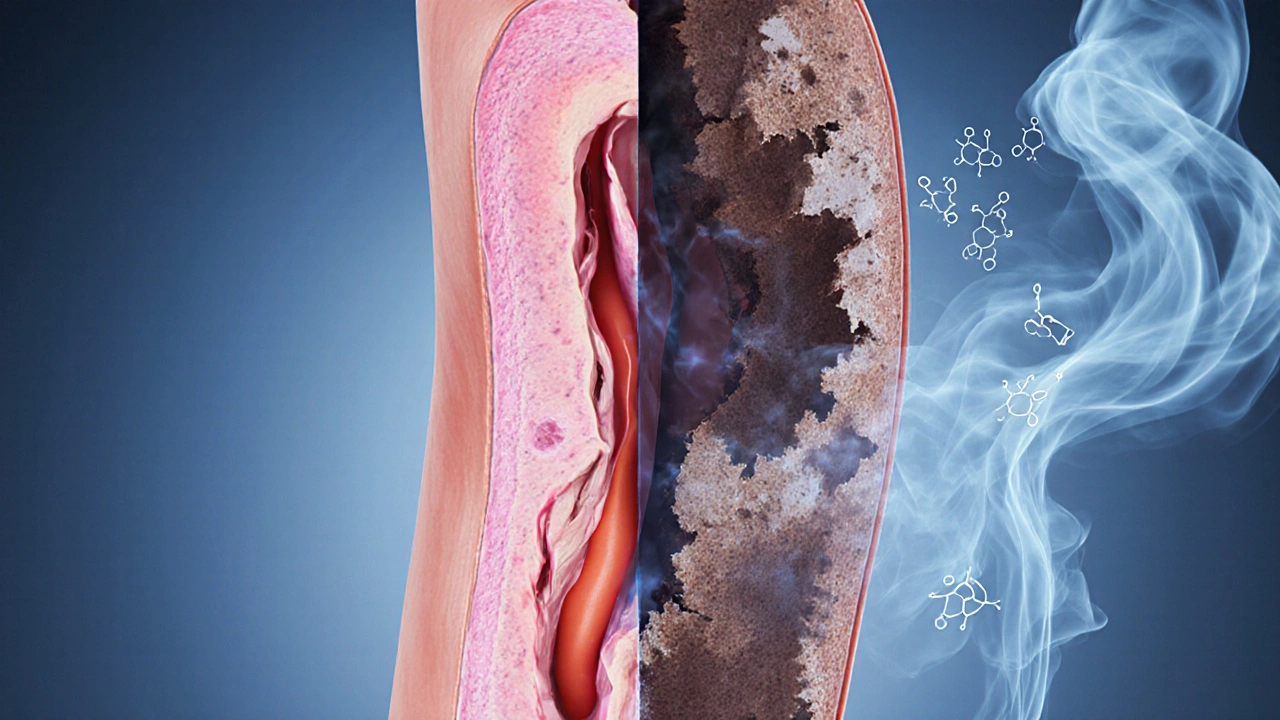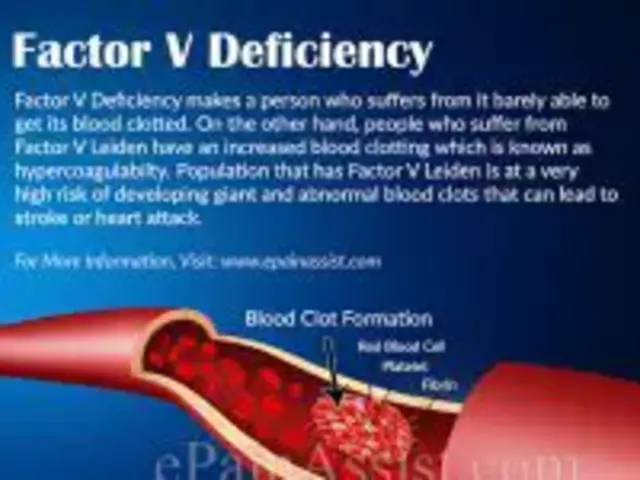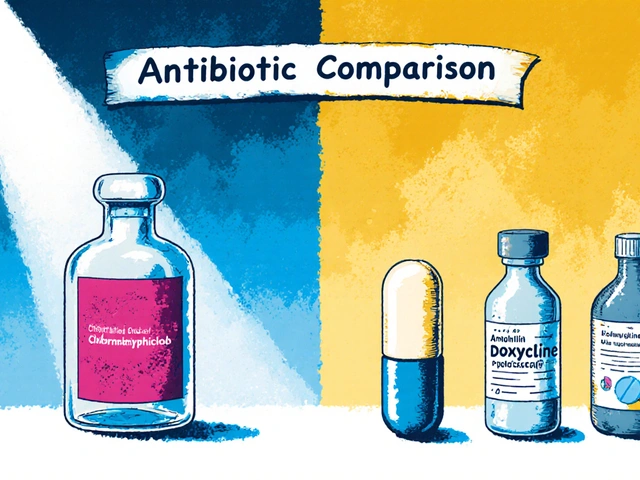Vascular Health Risk Calculator
Your Vascular Risk Profile
Coronary Artery Disease
Risk: 1.0x
Stroke
Risk: 1.0x
Ever wonder why a cigarette feels like a quick break but leaves a lasting mark on your blood vessels? The truth is, each puff sets off a chain reaction that narrows arteries, spikes blood pressure, and paves the way for serious illnesses. Below you’ll find the exact ways tobacco harms the vascular system, the diseases it fuels, and what you can do right now to protect your heart and circulation.
Quick Takeaways
- Smoking triggers endothelial dysfunction, oxidative stress, and chronic inflammation, all of which damage arteries.
- Relative risk for coronary artery disease, stroke, and peripheral artery disease can double or triple with a pack‑a‑day habit.
- Quitting reverses many vascular changes within months and cuts long‑term disease risk by up to 50%.
- Regular exercise, a diet rich in antioxidants, and routine vascular health checks help counteract lingering damage.
How Smoking Harms the Vascular System
When you light up, you inhale a cocktail of chemicals that immediately interact with the vascular system is the network of arteries, veins and capillaries that transports blood throughout the body. It supplies oxygen, nutrients, and removes waste, keeping organs functional.. The key mechanisms are:
- Endothelial dysfunction: The inner lining of blood vessels, called the endothelium, loses its ability to relax and dilate. Nicotine and thousands of other toxins damage endothelial cells, reducing nitric oxide production-a molecule essential for vessel flexibility.
- Oxidative stress: Smoke delivers free radicals that overwhelm the body’s antioxidant defenses. This leads to oxidative damage of lipids, proteins, and DNA within the vessel walls.
- Inflammation: Chronic exposure activates inflammatory pathways, causing the release of cytokines that attract white blood cells to the arterial wall.
- Platelet aggregation: Chemicals in smoke make platelets stickier, increasing the chance of clot formation.
- Carbon monoxide binding: Carbon monoxide from tobacco binds to hemoglobin more readily than oxygen, reducing oxygen delivery and forcing the heart to work harder.
These processes don’t act in isolation. Together they accelerate the formation of atherosclerosis is a condition where plaque-fat, cholesterol, calcium, and cellular waste-builds up inside arteries. The plaques thicken walls, narrow the lumen, and can rupture, leading to clots that block blood flow., the primary driver of most cardiovascular disease.

Major Diseases Linked to Smoking
Because the vascular system supplies every organ, smoking‑related damage shows up as a range of serious illnesses. Below is a snapshot of the most common conditions and how smoking amplifies each risk.
| Condition | Relative Risk (Smokers vs. Non‑smokers) | Key Vascular Mechanism |
|---|---|---|
| Coronary artery disease | 2.5‑3.0× | Endothelial dysfunction + plaque formation |
| Ischemic stroke | 2.0‑2.5× | Platelet aggregation + clot formation |
| Peripheral artery disease | 3.0‑4.0× | Atherosclerosis in limb arteries |
| Aortic aneurysm | 1.8‑2.2× | Chronic inflammation weakening vessel wall |
| Deep‑vein thrombosis | 1.5‑2.0× | Hyper‑coagulable state from platelet stickiness |
Notice how each condition ties back to the same vascular insults-damage to the endothelium, inflammation, and clot‑prone blood. That’s why quitting smoking can simultaneously lower the odds of heart attacks, strokes, and limb‑loss‑causing PAD.
How Risk Grows Over Time
Risk isn’t static; it climbs the longer you smoke and drops once you quit. Epidemiological data from the Global Burden of Disease study (2022) show:
- After 5 years of daily smoking, a person’s risk for coronary artery disease is roughly double that of a never‑smoker.
- After 10 years, the risk for stroke climbs to about 2.5 times higher.
- Even after 20 years, smokers retain a 30‑40% excess risk compared with lifelong non‑smokers.
But the good news is equally clear. Women who quit before age 40 cut their heart‑disease risk by over 90%. For anyone who quits after 50, risk still drops by 30‑50% within a decade.
Warning Signs Your Vessels Are Paying the Price
Vascular damage can be silent, but some clues may surface:
- Claudication: Cramping pain in the calves or thighs during walking, often a sign of peripheral artery disease.
- Chest discomfort during exertion, hinting at reduced coronary blood flow.
- Sudden, unexplained headaches or visual changes, which can precede a stroke.
- Persistent cold hands or feet, a result of narrowed peripheral vessels.
If any of these symptoms appear, schedule a vascular assessment-Doppler ultrasound, ankle‑brachial index, or a simple blood pressure check can catch trouble early.

Benefits of Quitting: What Happens to Your Vessels?
When you stop smoking, the body starts repairing itself almost immediately:
- Within 20 minutes, heart rate and blood pressure drop toward normal.
- After 12 hours, carbon monoxide levels fall, allowing oxygen to bind hemoglobin more efficiently.
- Within 2-12 weeks, circulation improves as capillary function returns and coughing lessens.
- One to three years later, the risk of coronary heart disease is half that of a continuing smoker.
- After 10 years, the risk of lung cancer, stroke, and PAD approximates that of someone who never smoked.
These timelines underscore that it’s never too late to quit-your vessels thank you at every stage.
Practical Steps to Protect Vascular Health
Even if you’re not ready to quit today, you can still blunt the damage. Here’s a plan you can start right away:
- Set a quit date within the next 30 days. Use apps or nicotine‑replacement therapy to manage cravings.
- Boost antioxidant intake - eat berries, leafy greens, nuts, and fish rich in omega‑3 fatty acids.
- Exercise regularly - 150 minutes of moderate aerobic activity per week improves endothelial function.
- Monitor blood pressure and cholesterol at least annually; ask your doctor about a full lipid panel.
- Stay hydrated - adequate water supports blood volume and reduces clot risk.
- Limit alcohol - excessive drinking compounds nicotine’s effects on platelets.
- Schedule a vascular screening if you’ve smoked for more than 10 years or have a family history of heart disease.
Combine these habits with a supportive network-friends, family, or a quit‑smoking group-and you’ll dramatically lower your future disease burden.
Frequently Asked Questions
Can occasional smoking still damage my arteries?
Yes. Even light or social smoking introduces enough toxins to trigger endothelial dysfunction and oxidative stress. Studies show that occasional smokers have a 1.5‑fold higher risk of coronary disease compared with never‑smokers.
How long does it take for my blood vessels to heal after I quit?
Improvements begin within weeks, but full reversal of atherosclerotic plaque can take years. Most measurable benefits-lower blood pressure, better endothelial function, and reduced clotting-appear within 3‑12 months.
Is nicotine the main culprit, or are other chemicals more dangerous?
Nicotine drives addiction and raises heart rate, but the thousands of other chemicals-especially carbon monoxide, tar, and free radicals-cause the bulk of vascular injury. It’s the combined effect that fuels disease.
Do e‑cigarettes pose the same vascular risks?
E‑cigarettes still deliver nicotine and oxidative chemicals, though usually fewer carcinogens. Emerging data link vaping to endothelial dysfunction and increased arterial stiffness, so they aren’t a safe alternative for vascular health.
Can my diet fully offset the damage from smoking?
A heart‑healthy diet helps, but it can’t completely neutralize the direct toxic effects of smoke. The most effective strategy is to quit smoking first, then support recovery with nutritious food and exercise.
Understanding how smoking attacks the vascular system turns a habit into a preventable health threat. Armed with this knowledge, you can take decisive steps-quit, get screened, and adopt protective habits-to keep your arteries clear and your heart beating strong for years to come.








18 comments
Ian Frith
Picture this: a lone ember flickers, but the damage it writes on your arteries is anything but solitary. Each puff sends a wave of oxidative stress that assaults the endothelial lining, turning your vessels into a battlefield of inflammation and clotting. Over time, that battlefield expands, paving the way for atherosclerotic plaques that can rupture without warning. The good news is that this story has a decisive plot twist-you hold the pen, and you can rewrite it by quitting now. Your body starts repairing the damage within minutes, and the longer you stay smoke‑free, the more your vascular health rebounds.
Beauty & Nail Care dublin2
Yo! 🚬🔥 we all know that cigs are like tiny time‑bombs for our veins, right?? but guess what-your heart ain't a superhero, it needs a break from the toxic fog. quit now & feel the magic 🌟. plus, the gov't doesn't want u to live long... lol 🙄
Oliver Harvey
Oh, wonderful, another post telling us that smoking is bad-who could have guessed? The chemistry class we skipped in high school clearly missed the memo. :)
Ben Poulson
It is well‑established in the literature that tobacco consumption precipitates endothelial dysfunction, oxidative stress, and heightened platelet aggregation, thereby substantially elevating the probability of coronary artery disease and cerebrovascular accidents.
Raghav Narayan
Smoking initiates a cascade of pathological events that begin the moment the inhaled smoke contacts the vascular endothelium, impairing its ability to produce nitric oxide, a crucial vasodilator.
The loss of nitric oxide leads to vasoconstriction, raising systemic blood pressure, which in turn imposes additional shear stress on arterial walls.
Simultaneously, the myriad free radicals present in tobacco smoke generate oxidative stress, damaging cellular membranes and DNA within endothelial cells.
These oxidative insults activate inflammatory pathways, recruiting cytokines and leukocytes that further degrade the structural integrity of the vessel wall.
Platelets, rendered hyper‑reactive by nicotine and carbon monoxide, begin to aggregate more readily, forming micro‑thrombi that can obstruct capillary flow.
Over months and years, these processes promote the formation of atherosclerotic plaques, consisting of lipids, fibrous tissue, and calcifications, which progressively narrow the arterial lumen.
When plaques become unstable, they may rupture, exposing thrombogenic material that precipitates acute occlusive events such as myocardial infarction or ischemic stroke.
Epidemiological data consistently demonstrate that a pack‑a‑day habit can increase the relative risk of coronary artery disease by up to threefold and stroke by up to two‑and‑a‑half times.
Furthermore, peripheral artery disease, aortic aneurysms, and deep‑vein thrombosis all share smoking as a common etiological factor, underscoring the systemic reach of vascular injury.
Importantly, the vascular damage is not irreversible; cessation of smoking initiates a rapid decline in carbon monoxide levels, restoring oxygen transport within 12 hours.
Within weeks, endothelial function begins to improve, and platelet activity normalizes, reducing the immediate risk of clot formation.
Longitudinal studies reveal that after one year of abstinence, the risk of coronary events drops by approximately 50 % compared with continued smokers.
By the decade mark, former smokers’ risk of stroke and peripheral artery disease approximates that of lifelong non‑smokers, illustrating the profound benefits of sustained quitting.
Adopting adjunctive lifestyle measures-regular aerobic exercise, a diet rich in antioxidants, and routine blood pressure monitoring-can accelerate vascular recovery and further diminish residual risk.
In sum, while each cigarette delivers a toxic payload to the circulatory system, the body possesses a remarkable capacity for repair, provided the exposure is terminated and supportive health habits are embraced.
Tara Phillips
Indeed, the evidence you presented underscores both the severity of the threat and the remarkable resilience of the cardiovascular system when we commit to cessation and healthy living.
Benjamin Herod
The smoke clouds your destiny.
luemba leonardo brás kali
Precisely; inhaled toxins compromise endothelial integrity, accelerating atherogenic processes that diminish lifespan.
Corey McGhie
Look, if you enjoy paying extra for heart attacks and strokes, keep lighting up-otherwise, grab a quit plan and start treating your arteries like you treat your prized playlists: with regular updates and no skipping tracks.
Ajayi samson
Statistically, each additional cigarette multiplies your healthcare costs, and the marginal utility of nicotine rapidly approaches zero as vascular degradation escalates.
Lief Larson
Smoking is like a bad remix of your blood flow it just messes up the rhythm and leaves you out of sync
Julia Grace
Totally feel ya-it's like your veins are dancing to a broken beat and then boom, a clot drops the bass.
Sadie Bell
Quitting isn’t just a choice; it’s a power move. Your heart will thank you.
Noah Bentley
Yeah, because your heart totally loves being a chain‑smoker-said no cardiologist ever.
Kathryn Jabek
In the grand tapestry of human health, tobacco serves as a deliberate fraying thread, meticulously unraveling vascular integrity; to persist in its use is to invite an avoidable demise with calculated indifference.
Emily Wang
Well put-so let’s cut the fraying thread now, not later, and give our arteries a fighting chance.
Hayden Kuhtze
Oh great, another reminder that smoking kills, because we totally needed that news flash.
Craig Hoffman
Yep, smoking is bad, quit it.